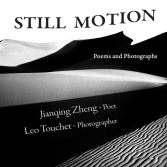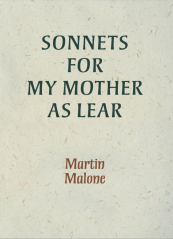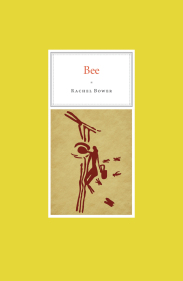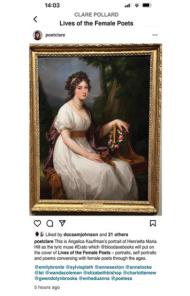
Maggie Harris, I Sing to the Greenhearts,
Seren, 2025, ISBN: 978-1-78172-771-3,
60pp, £10.99.
There is no danger that in terms of trades description Maggie Harris should be reported to the appropriate authorities. She fulfils the promise in the collection’s title continually with poems that unequivocally sing from the page. This is a defining feature of her work and guaranteed to make her stand out in a field where most poetry is designed to be spoken and quietly at that.
The fact that Harris is not afraid to let rip makes for an exhilarating read. I was reminded in much of her practice of Charles Olson’s projective verse poetics in which he argues for an approach that breaks free of form and measure. It might be argued that Olson is merely advocating for vers libre. However the examples of what is properly projective verse seem to exceed free verse which still keeps tightly to the left margin and the constraint of short lines. Harris like Olson simply will not be contained for the most part.
This is not to say that she cannot write quieter poems. ‘The Daydream, Dante Gabriel Rossetti’ (referencing the Pre-Raphaelite painter) for instance is a poem that exercises restraint. It sits comfortably on the page, conducive to being read silently. Segments are applied with delicacy and build subtly:
in your velveteen bed of sycamore forest,
your tresses of russet, the fallen rose
in your calamine palm, the open book.
But even here the poem takes off in the second final stanza with a flourish that soars beyond the constraints of the short lyrical poem:
Dream me beautiful to the cusp
of pain to splinter and woodlouse
to the last panther
to howler monkeys screaming
from the edges of the New World.
Notice the discarding of punctuation in these lines and the somewhat disjunctive syntax. This kind of propulsion is allowed full throttle for most of the collection with poems that dazzle with their energy, so teeming with imagery and ideas they sprawl away from that safe left hand margin before roaring off across the page in a race to the horizon.
The collection is bookended by two poems celebrating the greenheart tree, which is freighted with symbolic significance. The greenheart is hard and strong, very resilient and grows in Guyana, and therefore also representative of Harris’ Guyanese heritage. The apostrophic starting point of ‘I Sing to the Greenhearts’ addresses these threads with gusto while at the same time avoiding rose-tinted nostalgia. The savage exploitation of the natural world is acknowledged leading into present day ecological concerns: “So they’re saying now there are not enough/trees to filter the carbon to allow us to/breathe. The politician and his cowboys tear through/verdant forests like a virus razing/them to the ground.” While the timbre of the opening poem is spoken word, the final poem, ‘The Greenheart weaves a Tapestry of Songs’ is explicitly a song. It provides a rousing finale though not one that ignores the hardships of life in Guyana for the majority of its population and the continuous threats to the environment. The refrain is clear on this: “Oh the hard times of Guyana /In Guyana were very hard times”
While the power of the exploiters is seen to prevail, defiance though seemingly weak will not be crushed completely: “Don’t come near with machete/Don’t come near with cutlass/If yuh scratch one scratch or thief one leaf/is you will get chop not she”. In such resistance, however small, lies hope.
Throughout the collection the natural world is celebrated. Flowers and plants are featured, sometimes personified as in the gloriously defiant ‘Mr Plantain’ rendered in dialect:
Mr Plantain tek a long time to mek up his mind
if he green or yellow…
Mr Plantain tek he revenge from all dem
who drag he from the plantation
Her ear for formal English though is just as incisive, as in ‘Her Wedding Dress’, with its beautifully nuanced opening stanza:
Swinging from the washing line
taffeta and lace, faded now and limp
it lilts into the screech of herring gulls
and the dives of crows from a grey
un-anointed sky devoid of hummingbirds
Maggie Harris is to be applauded for giving us poems of such freshness and vivacity. In so doing she goes some way to returning poetry to its origins of being kinaesthetically connected with song, and with dance too for the rhythms delineated here invite movement and sway in response, for metrical feet to segue into the placing of actual feet.
David Mark Williams
To order this book click here
David Mark Williams writes poetry and short fiction. He has been shortlisted for the Montreal Poetry Prize and won Second Prize in the New Zealand Poetry Society International Competition. Two collections of his poetry have been published: The Odd Sock Exchange, Cinnamon, 2015 and Papaya Fantasia, Hedgehog, 2018.
Jianqing Zheng and Leo Touchet,
Still Motion: Poems and Photographs,
Photo Circle Press, 2025, ISBN: 979-8991832311, 64pp, $17.50.
Responding to Leo Touchet’s astounding black and white photographs of sand dunes in Death Valley and Texas, jazz funerals and festivals in New Orleans, and several other scenes, Jianqing Zheng’s ekphrastic poems capture and interpret the implicit movement in the images. The photographs and poems perform a splendid dance together, a tango or fox trot, on facing pages. The title of the collection, Still Motion, indeed, expresses the synergy of word and image.
The opening poem, “A Way of Seeing,” is written in a form that gives expression to the undulant, rippling nature of the dunes, Touchet’s sublime landscapes of light and shadow. It begins:
Those
sand
dunes
(tension
of time
and space
touch
of light
and shade
shape
of solitude
and company)
look
serene
and jumpy….
The sway of the words mimics the waves of sand. The photograph and the verse together seem to collaborate in a sort of samba, dancing across the facing pages.
The first ten ekphrastic duets are all based on these desert images. Zheng emphasizes the very act of seeing throughout his poetic responses to the photographs. “A Way of Seeing” is followed by poems titled “Questions from Seeing,” “The Visual Chord,” “Sight to Sight,” and “Seeing the Shadows.” As he writes in his introductory statement about ekphrasis, it “helps me focus on things, not ideas.”
Yet in seeing these images, his imagination is likewise stimulated. Five of the twenty-five pieces in the collection are haibun, a form that combines prose and haiku. “The Visual Chord” is one. It ends:
stranded on beach
a humpback whale
in desperate silence
Touchet’s accompanying photograph is “Mesquite Flats Sand Dunes” in Death Valley National Park, and the image certainly does resemble a beached whale, the way we see things in passing clouds in the sky; the light makes the rippled sand in the background of the photo appear to be a tranquil body of water stretching to the horizon while the darkened dune in the foreground could be Moby-Dick’s dark little cousin stranded on the shore.
“Ripple Effect,” likewise in response to a “Mesquite Flats Sand Dunes” image that depicts the windblown sand shifting, “a natural painting of lake ripples pushing on and on into more ripples stretching out of sight,” brings to the poet’s mind the vicissitudes of the economy and ends with the whimsical haiku:
pillow talk
about delayed retirement
delays sleep
The final sand dune-inspired poem, called “A Small Plant’s Valediction,” after Touchet’s “Monahans Sand Hills Dunes” photograph taken in Monahans Sand Hills State Park in Monahans, Texas, a close-up image of a small plant emerging from the sand, lying flat on the sandy ground, whose semi-circular ridges make the plant appear as if at the center of a clock (“I am an hour hand attached to your shaft”) is written from the plant’s point-of-view. “Dear Sand,” it begins, “don’t creep into sadness.”
“La Vie en Rose,” after a black-and-white close-up of a blooming flower that is reminiscent of Georgia O’Keefe, starts a suite of Louisiana-based photographs. Louis Armstrong famously performed the Édith Piaf-composed song, a jazz reference that signals the shift in geographical and cultural focus. Touchet’s images of jazz and blues musicians in this sequence freezes the dynamism on the page, the very essence of “still motion.”
There’s the beautiful “Bourbon Street in the French Quarter” photograph of two small kids gazing up at something overhead, their eyes wide in astonishment. The smaller boy has his lips on a toy trumpet while the older boy, arm around the smaller boy’s shoulder, points at something in the sky (Is it a bird? Is it a plane?). Zheng’s accompanying ekphrastic poem is titled “Wonder.” It’s one of those brief moments a perceptive photographer is able to capture forever in film.
“Second Line at Alcide ‘Slowdrag’ Pavageau’s Jazz Funeral” is another. It’s an image of young men in full dance motion, parasols overhead, arms and hips swinging with abandon. Zheng’s poem, “Celebration,” is shaped like a rocketship, or a maybe a roman candle, a Mardi Gras firework; though it’s a funeral procession, they are celebratory, not somber. Zheng writes:
images
of
the Second Line
hip
&
hop
strut
&
booty bounce
rejoicing
the
dead
Zheng’s poem, “B.B. King” accompanies a photograph of the legendary blues guitarist Touchet took in 1972 at the annual JazzFest, King’s big infectious grin lighting up
his face as he sits in an automobile. Outside the window we see fans looking on as the car passes. “Sunflowers bow with a hail,” Zheng writes.
A handful of other JazzFest photographs are included here, too, attendees frenetically dancing in one (Zheng’s accompanying poem is simply titled “JazzFest”), an audience sitting in the stands anticipating the performance in another (“Waiting” is Zheng’s ekphrastic poem).
One of the final images Touchet has captured is a silhouette of a man and woman kissing by the benches along the riverfront. “Lovers on the Mississippi Riverwalk” is paired with Zheng’s poem, “Being in the Moment.” The short poem reads:
Two lovers form a silhouette
in the halo
of the southern sunset,
heads tilting, eyes smiling.
Arms hugging
For a soulful presence.
She’s the crescent moon
throbbing
with his heartbeat,
and he Lake Pontchartrain
rocking her
into a mooring boat.
Still Motion is an aesthetically pleasing performance, the collaboration of a master poet and a master photographer.
Charles Rammelkamp
To order this book click here
Martin Malone,Sonnets for My Mother as Lear, Mariscat Press, 2025, ISBN: 978-1-0686756-3-8, 32pp, £7.50.
Martin Malone’s collection of twenty sonnets addresses a tricky diplomacy between a failing parent and her grown child who feels a moral obligation to care for her. The parent can be imperious and in denial, while the “child” feels the burden of a discretion that might seem to border on deceit, as he tries diplomatically to move his mother, Joan, into a care facility, for her own safety. It appears that not only is she prone to wander off but that her caregivers are taking advantage of her. In the second sonnet we read about the fish-eye lens the son has installed in the door:
We fit it to catch the girl who steals
from you, primed with more tech than
a moon shot.
The titles of the sonnets are lines from King Lear. The fourteenth sonnet, “By some discretion that discerns your state …” (from Act II, scene iv) spells out the situation:
Your Mam’s been found safe and we offered
her a placement which was, of course, declined;
She remembers me from last night, and that
she was brought home by the police but says:
I am an 86-year-old lady, just enjoying a day out
at the marina why all this fuss? I’ve no doubt
she has a point, until she adds that a man
with a gun pushed past her into the house.
The emergency duty team are on standby
over the weekend in case she does it again
and we’ve lined up some screening tests,
to rule out infection which can often affect
ladies of her age. Her own view of matters
remains positive, never less than ‘robust’.
This sonnet is in the voice of a care facility official. It’s painfully obvious that the woman cannot live alone. She’d wandered off and police had found her and brought her home. She maintains her innocence – just out for a stroll, what’s the big deal? She’s deluding herself, which adds to her son’s consternation.
While most of the poems are from the son’s point of view, several, like this one, are spoken by officials, or in the official bureaucratese of legal documents. One poem, “So young and so untender,” a line spoken by Cordelia in Act I, scene i, is in Joan’s voice. It’s her version of how she’d been taken advantage of by a caregiver. (Whenever Joan speaks the text is displayed in italics.)
She came dressed as a carer and said to me:
‘Hello, Joan’, she came about half-past three
and I said to her you don’t usually come to me
this late on a Sunday…
The woman steals Joan’s purse. Moreover, Joan has stopped bathing and changing her clothes, forgetting basic hygiene. No wonder her son is disturbed. Sonnet VIII, “I would prefer her to a better place (echoing Cordelia’s feelings about her father in Act I, scene i) is further evidence of the son’s concern.
She is able to express her own needs
and wishes, though these may not be
reliable due to short-term memory
loss. She has a tendency to mix up
her stories, telling the same one over
and over again.
Classic Alzheimer’s memory loss. “I’m just calling to tell you I saw her, / on the wander again in the town,” a well-meaning person tells Joan’s son, in sonnet XV, and in XVI he’s still agonizing about his “deception”:
We’ve long known this works on the basis
of catastrophe-response, but — in the face
of your fierce will – we tourniquet my stress
and let you have your way.
And then the inevitable happens, and Joan has a fall, and he has to use the Power of Attorney to make the decision to move her into a care facility.
Far off, methinks, I hear the distant drum
as she calls down curses on a weeping son.
I love that “methinks” and its Elizabethan echoes. In general the language of these fourteen-line poems is modern English, but there’s an overall atmosphere of ancient drama.
The fall came only the day after he’d had motion cameras installed all over her house. Sonnet XVII ends: “When they move you to the care home / I can hardly wait to enter through Traitor’s Gate.” He continues to feel like he’s betrayed his mother.
Oddly, the collection puts a whole new gestalt on the Lear tragedy. Yes, we knew Shakespeare’s king was “mad” and he had trust issues with his children, but dementia puts a whole new spin on the situation; it’s no longer that classic “pride” that comes before the fall. At the same time, it recasts dementia as a tragedy of universal proportions. Indeed, the epigraph to the collection, also from King Lear, Act II, scene iv, suggests something similar:
Whereto our health is bound; we are not ourselves
When Nature, being oppress’d, commands the mind
To suffer with the body.
The final poem, “We two alone will sing like birds i’ th’ cage” (Lear to Cordelia, Act V, scene iii) ends on a triumphant note. The house has been cleared for sale, and Joan, his “dauntless mother,” now in a care facility, is adjusting to her new circumstances. She is down in the lounge when her son comes to visit, “holding hands / and dancing, laughing with new friends.” The poem ends on this moment of recognition:
you see me or someone like me you know,
hold out a hand to join you in your dance
and, of course, you’ve no idea who I am,
though now, at last, I think I know you.
Charles Rammelkamp
To order this pamphlet click here
Charles Rammelkamp is Prose Editor for BrickHouse Books. His latest collection is The Trapeze Of Your Flesh (BlazeVOX Books).






